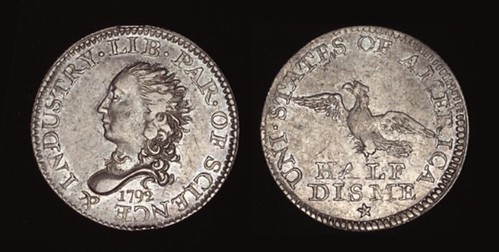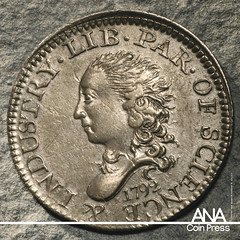
PREV ARTICLE
NEXT ARTICLE
FULL ISSUE
PREV FULL ISSUE
THE HISTORY OF THE 1792 HALF DISMEIn July the American Numismatic Association posted on the ANA blog an article on the history of the 1792 Disme. Originally published in The Numismatist August 2017, it was written by Pete Smith, Joel J. Orosz & Leonard Augsburger and won the Heath Literary Award that year. Here's a short excerpt - the complete article is available online. -Editor A MORE ACCURATE HISTORY OF THE 1792 HALF DISME A tale of three sources, two strikes and one president.
Two seemingly authoritative sources that surfaced during the mid-19th century provided answers to these questions. They corroborated some assertions and contradicted others. Inevitably, collectors, dealers and scholars chose sides and argued for 150 years about which source was more credible and which story was more plausible. Unbeknownst to these bickering numismatists, however, the definitive answers to these vexing questions were recorded by a third and very reliable source. Information from that reference dribbled out slowly between 1966 and 2003, and glimpses of the story emerged. However, it was not until we thoroughly examined this third source that a more accurate history of the half disme could, for the first time, be revealed. The “extended version” of that history, along with that of the other 1792-dated coins, appear in our book 1792: Birth of a Nation's Coinage, published in 2017 by the Ivy Press, a subsidiary of Heritage Auctions. The story of the half disme begins with its obscure gestation, striking and distribution. When it was struck in 1792, hardly anyone took notice. No announcement was made, no “first strike” ceremony was recorded, and not a single newspaper in Philadelphia, or anywhere else, covered the story. Modest in appearance and comparatively few in number, the half dismes vanished from the scene just as quietly as they arrived. Over the next 40 years, pioneering coin collectors encountered, every now and again, tiny silver U.S. 5-cent pieces that carried the peculiar word “disme.” They wondered about the whys and wherefores of these enigmatic coins, but in the early 1830s, numismatic knowledge was sparse. No books or magazines focused on American coins; no coin clubs existed; written records were scattered; and collectors toiled in isolation. An enterprising numismatist might have contacted mint personnel to seek information, but by the early 1830s, all of the men who had worked on the first federal coinage of 1792 were long since dead, leaving only the faintest of paper trails. The first collectors who added half dismes to their cabinets, therefore, could only admire them in wonderment. A few were more proactive. In 1838, for instance, William G. Stearns of Boston wrote to Mint Director Robert M. Patterson, asking for a detailed description of the all-but mythical 1792 half disme. Patterson obliged by sending basic information about the piece, but enclosed no illustration. At the end of the 1830s, at long last, the flywheel of numismatic knowledge slowly started to turn. In 1839 the Reverend Joseph B. Felt wrote the first American book with significant numismatic content, An Historical Account of the Massachusetts Coinage. Three years later, U.S. Mint Assayers Jacob B. Eckfeldt and William E. Dubois produced A Manual of Gold and Silver Coins of All Nations, featuring engraved illustrations. Half dismes had disappeared from circulation by 1842, so the manual did not mention them. Dubois was back in print in 1846 with Pledges of History, a guide to the mint's coin cabinet. He was the first author to mention the 1792 half disme, thus confirming its genuineness, but since the book was not illustrated, collectors still wondered what the piece looked like. Finally, in 1857, as coin collecting was experiencing a boom, Norton's Literary Letter (a periodical for bibliophiles) published the first engraving of this petite 5-cent piece. And, 67 years after the half dismes were struck, Dr. Montroville Wilson Dickeson, the “Indiana Jones” of his day, wrote the first comprehensive guide to the hobby, The American Numismatical Manual. Quaint though Dickeson's spelling might have been, his technology was fairly sophisticated, for his book included 19 plates of tinted facsimile illustrations, including a half disme. Collectors at last had basic information and images for reference. 
To read the complete article, see:

Wayne Homren, Editor The Numismatic Bibliomania Society is a non-profit organization promoting numismatic literature. See our web site at coinbooks.org. To submit items for publication in The E-Sylum, write to the Editor at this address: whomren@gmail.com To subscribe go to: https://my.binhost.com/lists/listinfo/esylum All Rights Reserved. NBS Home Page Contact the NBS webmaster 
|
